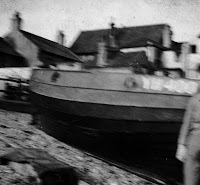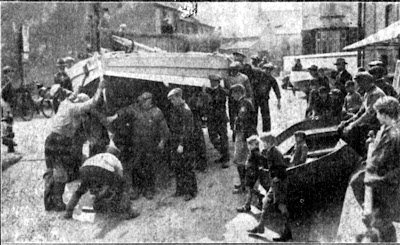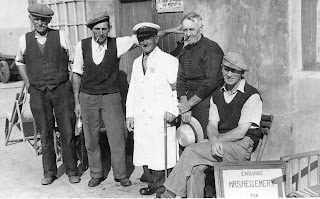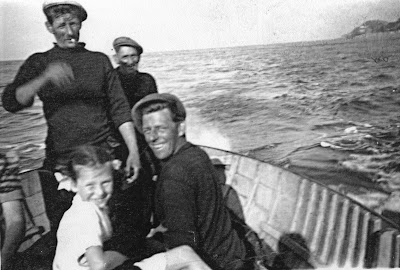Since the end of the war, my brother Jack and I had been going to sea with our uncle Henry Willie in his crab boat Acadia YH400. This was our apprenticeship into the fishing business and we had a lot to learn.
 |
| 'Acadia' YH400 on Sheringham East Beach |
Crab and lobster catches on the North Norfolk coast recovered quickly after the bitter winter of 1947, so there was a living to be made from the sea.
By the following year father thought that Jack and I had learnt all we could from his brother! So, he offered to pay for a new crab boat to be built, if Jack and I agreed to go with him. It was an offer we could not refuse as Jack and I had little spare cash at that time to buy fishing gear let alone a new boat.
Uncle Henry Willie was not happy as he would have to find a new partner to go with him but he finally teamed up with my friend Sid ‘Plug’ Emery in Sid’s new crab boat ‘Enterprise’.
Father had a choice of two boat builders in Sheringham. One was Johnny Johnson and the other was Reginald Emery and his sons.
Johnny Johnson’s workshop, the ‘Old Boathouse’, was in Cremer Street near Myrtle House, and Emery’s was on Lifeboat Plain next to Gun Street where I was born. As a youngster, I remember the excitement when a new boat was brought out of both workshops, onto the road and down to the sea for the first launch.
Johnny Johnson built well over 100 boats of different sizes, including a 36 foot fishing smack for Roger Quilter and the 25 foot ‘Marion’ for the Wells lifeboat coxswain Theodore Nielsen in 1930.
 |
| Johnny Johnson (right) and fishermen inspecting ‘Marion’ |
 |
| Theodore Nielsen (3rd from left) and ‘Marion’ |
 |
| ‘Marion’ near East Beach Entrance |
By 1948, Johnny was not in the best of health. He planned to retire in a year or so, but I don’t know if this influenced father’s decision to put his money down with the Emery’s.
The Emery boat building dynasty stretched back to the 1860's and, like Johnny Johnson, they had built larger craft such as ‘Knot’ LN95 for the Bullard family in 1938.
 |
| Reginald & Jimmy Lewis Emery with 'Knot' |
 |
| Knot LN95 in Morston Harbour 1938 |
Here is Reginald and others after the war.

L-R: Reginald Emery, Roger Emery, Joseph ‘Jo’ Life (Beach Inspector and former member of Fred Karno’s Army, working with Charlie Chaplin and Stan Laurel before they went to America), Charlie ‘Chicken’ Grice and Chris Emery.
Emery's used a two storey building on Lifeboat Plain which had enough space on the two floors for up to 3 boats at any time.
 |
| Emery’s Workshop on Lifeboat Plain in 1970’s |
After the war, Emery’s were very busy with orders for whelk boats as well as crabbers. Father’s boat was laid down in the upper storey in early 1949. At that time the Emerys were working on a whelk boat on the ground floor. This was the 30 ft 'William Edward' which was the largest whelk boat built in Sheringham, and so the final painting and fitting out had to completed outside.
 |
| ‘William Edward’, whelker built for Cyril Grimes of Wells in 1949 |
I and brother Jack tarred the lower hull of ‘William Edward’ so that the Emerys could be freed up to work on father’s boat.
‘William Edward’ was completed in April 1949 and a large gang of helpers came to move her by skeets out onto the cliff, up the High Street, down Wyndham Street and Beach Road to the entrance of the East Beach
 |
| William Edward on Sheringham High Street, April 1949 |
 |
| William Edward at the entrance to East Beach (Henry 2nd left) |
Many in the local community, not just the fishermen, took part in these boat launchings from both Johnny Johnson's and the Emery's yards.
Father had to chose a name for his new boat and suggested to mother that the boat should be named after her – ‘Bessie’. Mother said ‘no, but how about our boys?” meaning ‘ Henry & Jack’ or ‘H & J’. Father mis-understood and our boys became ‘Our Boys’. By the time that Maurice Wilton, the local signwriter, had finished his work it was too late, but no-one minded.
Needless to say, Jack and I were very proud of ‘Our Boys'. She was a wonderful sea boat and kept us safe for over 40 years of fishing.
 |
| Henry, Jack and ‘Our Boys’ in the early 1950s |
 |
| Henry, Bob and Jack with a young visitor in ‘Our Boys’ |
 |
| Tripping party in 'Our Boys' Early 1950's |
Thanks to Johnathon Emery and David Hewitt for extra information.